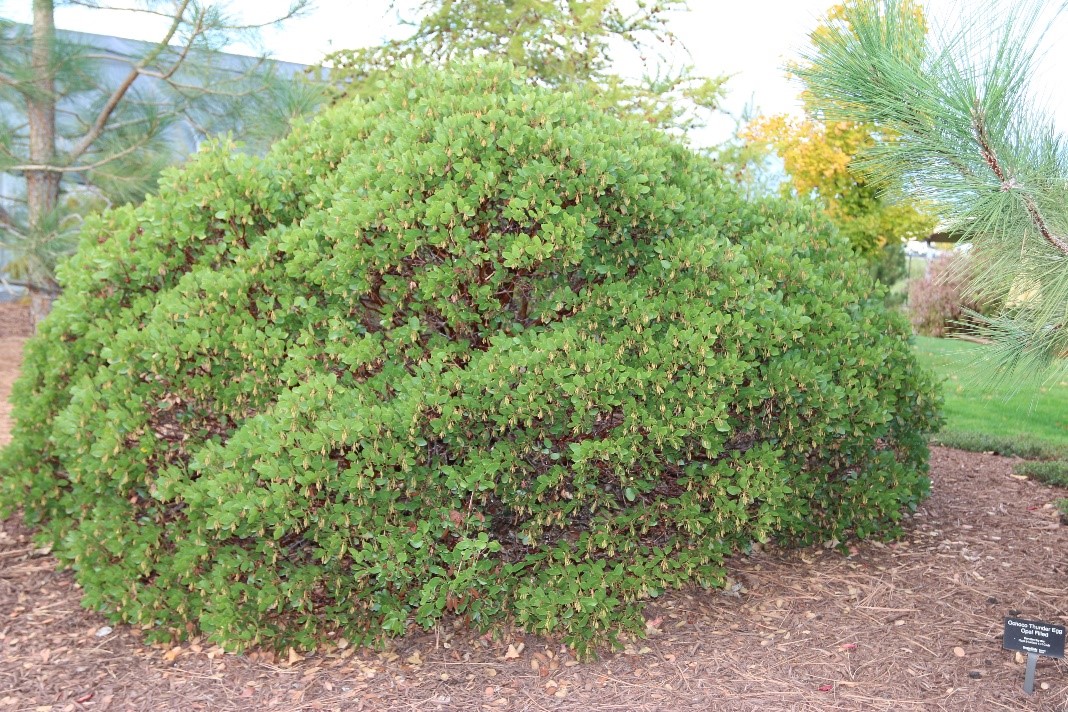Greenleaf Manzanita in the Landscape

Amy Jo Detweiler, Oregon State University Extension Service
Scientfic Name: Arctostaphylos patulaCommon Name: Greenleaf manzanita
Description: A medium sized dense, evergreen shrub that has an oval, somewhat spreading habit with shiny leaves and distinct, beautiful, reddish-brown bark. Older bark will peel off leaving smoother bark that is part of this shrubs defense mechanisms against climbing insects. Pinkish-white flowers in early spring attract bees and butterflies. The name manzanita means “little apple” in Spanish, referring to the tiny red fruit it forms.
Native Habitat: In North America, native range from Washington through the Oregon Cascades and through the Sierra Nevada to the Coast Range of Northern California, east to the Great Basin and western Colorado, and south to the higher elevations of northern Arizona. Found from 2,000 to 9,000 feet in elevation.
Cultural Requirement
Soil: Prefers sandy, well-drained, slightly acidic soils. Found in open coniferous forests with dry, well-drained sandy loam to silty loam soils.
Moisture Tolerance: Drought tolerant. Prefers dry sites.
Sun/Shade/Preference: Full sun to part shade.
Transplanting: Transplant starts into small containers using sterile potting soil. Once they are rooted in small containers they can be potted up and grown and rooted in #1 containers. Manzanitas generally do not transplant well (roots do not like to be disturbed), so they should be grown to healthy size, then moved into the landscape in the late fall or early winter.
Propagation: Vegetative propagation is recommended for greatest success. Greenleaf manzanita is most easily propagated by cutting terminal shoots that include 1-2" of the woody stem from the previous year. Cuttings should be taken between March and May and should be dipped in a rooting hormone before being placed in a moist sand-peat mixture. Keep cuttings moist through regular misting or watering until roots appear then transplant. Propagation by seed can be difficult.
Maintenance (pruning, fertilization, deadheading, division, irrigation, etc): Low maintenance plant. Water upon planting until established then very drought tolerant. Can be lightly pruned post bloom, but is not required. No fertilization is required.
Insect, disease, or other problems: No serious pest or disease issues. On occasion it may get manzanita leaf gall aphids (Tamalia), Botryosphaeria dothidea (fungal canker) and leaf spot.
Landscape Value
Use in the Landscape: Can be used as an accent plant, in mass planting, rock gardens, and naturalizing and woodland gardens.
Weediness/Invasive Potential: Not know to be invasive.
Foliage: Evergreen leaves are simple, green, shiny, leathery, elliptical and smooth often 1-2" in size. This plant holds its leaves through winter providing seasonal interest.
Flower: Terminal clusters of small bell-shaped flowers. Pinkish-white blooms appear in late spring. Attracts pollinators such as native bees and butterflies.
Timing: April - June
Fruit: Small, reddish-brown to black berry-like drupe type fruit about ¼" in size.
Form: Upright, oval, somewhat spreading growth habit with a gnarly, strong architectural branching habit.
Texture: Medium
Ultimate Size: Height 4-6' and spread 4-6'
Rate of Growth: Slow the first few years then moderate.
Suggested Plant Partners: Abies concolor, Abies magnifica, Cercocarpus ledifolium, Cornus sp., Juniperus occidentalis, Notholithocarpus densiflorus, Physocarpus capitatus, Pinus sp., Populus tremuloides, Quercus chrysolepis, Berberis aquifolium, Ceanothus sp., Eriogonum sp., Frangula sp., Lonicera sp., Rhododendron columbianum, and Vaccinium sp.
Availability: Nurseries growing the plants can be found at Oregon Association of Nurseries website nurseryguide.com
Cultivars: 'Altura'
References:
Wilken, D., and Burgher, J. 2002. Greenleaf Manzanita Plant Fact Sheet. USDA NRCS Northeast Plant Materials Program.
Native Plant Society of Oregon Klamath Basin Chapter, Common Plants of the Upper Klamath Basin. 2007. Koko Graphix. Klamath Falls, Oregon.
Kruckeberg, Arthur, R.1996. Gardening with Native Plants of the Pacific Northwest. University of Washington Press, Seattle, Washington.
Jensen, Edward C. 2013. Shrubs to Know in Pacific Northwest Forests. Oregon State University Extension Service EC 1640.
Breen, P. Oregon State University Department of Horticulture Landscape Plants Website. https://landscapeplants.oregonstate.edu/plants/arctostaphylos-patula
